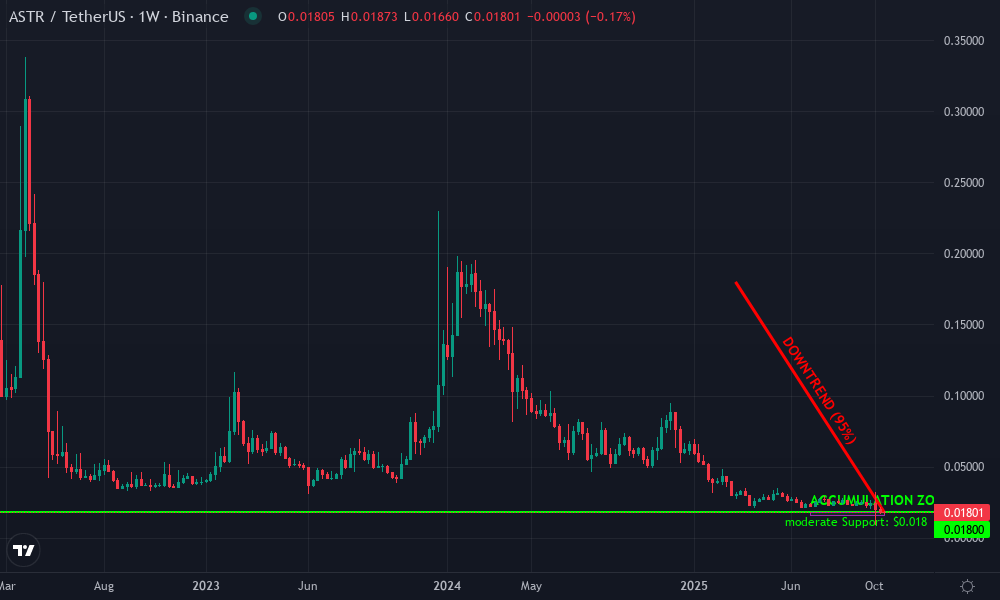
Few phenomena in decentralized finance have generated as much intrigue in 2025 as the meteoric rise of Aster Perp DEX. On October 6, Aster posted a staggering $41.78 billion in 24-hour trading volume, decisively outpacing rivals Lighter ($10.13 billion) and Hyperliquid ($9.02 billion). This level of activity marks not just a new high-water mark for Aster but a paradigm shift in the race for perp DEX market share.
Astar Technical Analysis Chart
Analysis by Grant McKinley | Symbol: BINANCE:ASTRUSDT | Interval: 1W | Drawings: 3
Technical Analysis Summary
Given the persistent downtrend visible since Q1 2024, draw a primary descending trend line from the major high in late Q1 2024 (~$0.18) through each subsequent lower high, ending at the current week’s candle near $0.018. Mark horizontal support at $0.018—this coincides with the current price and recent local lows. Add a weak resistance line at $0.025, where minor bounces occurred mid-2025. Shade a consolidation box between $0.015 and $0.022 to highlight recent price compression. Add a rectangle for the major accumulation zone between $0.010 and $0.018, as this is where price has stabilized. Annotate with text/callouts noting the persistent downtrend and lack of strong reversal signals. MACD/volume callouts should note low momentum and volume spikes mostly on down candles. Use arrow markers to highlight attempted but failed breakouts above $0.025.
Risk Assessment: high
Analysis: The persistent downtrend, lack of evidence for accumulation, and failure to hold prior support levels highlight elevated risk. Despite strong fundamental protocol performance, token price action is overwhelmingly bearish with no technical reversal signals.
Grant McKinley’s Recommendation: Do not initiate new long positions until a confirmed trend reversal or clear fundamental catalyst emerges. Conservative investors should remain on the sidelines and monitor for signs of structural accumulation or macro-driven sentiment shifts.
Key Support & Resistance Levels
📈 Support Levels:
-
$0.018 – Current price floor, tested multiple times in late 2025.
moderate -
$0.015 – Lower support, represents absolute price exhaustion zone.
weak
📉 Resistance Levels:
-
$0.025 – Minor resistance from brief rally attempts in mid-2025.
weak
Trading Zones (low risk tolerance)
🎯 Entry Zones:
-
$0.018 – Potential accumulation for high-conviction, deep-value plays only, but risk is elevated.
high risk
🚪 Exit Zones:
-
$0.025 – First logical profit target if mean reversion occurs.
💰 profit target -
$0.015 – Stop loss for any speculative long position, as breakdown below signals further capitulation.
🛡️ stop loss
Technical Indicators Analysis
📊 Volume Analysis:
Pattern: Volume is subdued overall, with periodic spikes on selloffs, signaling capitulation, not accumulation.
Low volume on up moves; volume spikes on down candles. No sign of sustained buying interest.
📈 MACD Analysis:
Signal: Bearish/flat
MACD likely remains below signal, reflecting persistent negative momentum and absence of bullish divergence.
Applied TradingView Drawing Utilities
This chart analysis utilizes the following professional drawing tools:
Disclaimer: This technical analysis by Grant McKinley is for educational purposes only and should not be considered as financial advice.
Trading involves risk, and you should always do your own research before making investment decisions.
Past performance does not guarantee future results. The analysis reflects the author’s personal methodology and risk tolerance (low).
Aster’s Volume Surge: What Sets It Apart?
While many platforms claim innovation, Aster has delivered tangible results that resonate across both retail and institutional segments. Its $41.78 billion daily volume is not an isolated spike but the culmination of strategic design choices and relentless execution. For perspective, this figure is more than quadruple the daily volume of its nearest competitor, underscoring Aster’s newfound dominance in perpetual trading.
What’s driving this outsized performance? Three pillars stand out:
- Robust Tokenomics and Incentives: Aster’s reward structure is engineered to maximize user engagement without diluting long-term value. Traders are incentivized not just by fee rebates but also by innovative staking programs that align interests between users and the protocol.
- Technological Infrastructure: Execution speed and reliability have become table stakes in the perp DEX arms race. Aster’s advanced matching engine delivers near-instant order fulfillment and minimal downtime, rivaling even centralized exchanges for latency-sensitive strategies.
- Liquidity Depth: Deep liquidity pools ensure tight spreads and minimal slippage, making Aster especially attractive for whales and high-frequency traders looking to deploy capital efficiently at scale.
The Competitive Landscape: Outpacing Lighter and Hyperliquid
The perpetual DEX sector has never been more competitive or better capitalized, with monthly trading volumes across all platforms recently surpassing $1 trillion for the first time. Yet it’s Aster that has broken away from the pack in recent weeks, its open interest now stands at $4.86 billion, while generating an impressive $13.44 million in daily fees.
Lighter and Hyperliquid remain formidable challengers, Hyperliquid notably leads in open interest with $14.68 billion, but neither has matched Aster’s explosive combination of volume growth and fee generation this quarter. The ability of Aster to attract both speculative traders seeking leverage and sophisticated participants deploying liquidity is reshaping expectations for what a leading perpetual DEX can achieve.
A Closer Look at User Experience and Product Innovation
A critical ingredient behind Aster’s ascent lies in its relentless focus on user experience, a factor often overlooked amidst technical debates about throughput or composability. Recent updates have made onboarding seamless for new users while retaining advanced features prized by professionals: customizable dashboards, real-time risk analytics, and intuitive mobile interfaces rival any centralized alternative.
Perhaps most notably, Aster stands out by offering synthesized perpetuals on equities: users can trade crypto-settled perpetual contracts on blue-chip stocks like Apple or Tesla with up to 50x leverage, an innovation that blurs the line between traditional finance and DeFi-native products.
Aster (ASTER) Price Prediction 2026-2031
Professional price forecast based on Aster’s dominance in the Perp DEX market, market cycles, and evolving industry trends.
| Year | Minimum Price | Average Price | Maximum Price | Year-Over-Year % Change (Avg) | Market Scenario Insights |
|---|---|---|---|---|---|
| 2026 | $0.95 | $1.35 | $1.85 | +18% | Consolidation phase after rapid 2025 growth; possible correction but strong user retention. |
| 2027 | $1.10 | $1.68 | $2.30 | +24% | Renewed growth as DEX adoption increases and regulatory clarity emerges. |
| 2028 | $1.35 | $2.05 | $2.90 | +22% | Mature Perp DEX market; potential for new institutional capital inflow. |
| 2029 | $1.60 | $2.42 | $3.55 | +18% | Technology improvements and cross-chain integrations drive usage. |
| 2030 | $1.85 | $2.85 | $4.25 | +18% | Bullish scenario with further global adoption; competition intensifies but Aster maintains leadership. |
| 2031 | $2.10 | $3.30 | $5.10 | +16% | Market stabilizes; Aster solidifies position as leading Perp DEX, but faces pressure from new entrants. |
Price Prediction Summary
Aster (ASTER) is well-positioned for continued growth given its current dominance in the perpetual DEX market, robust tokenomics, and technological edge. After a period of potential consolidation in 2026, the token is likely to benefit from broader DEX adoption, regulatory clarity, and further platform innovations. While competition and market cycles may introduce volatility, Aster’s strong foundation suggests a positive long-term price trajectory.
Key Factors Affecting Aster Price
- Sustained trading volume leadership and deep liquidity pools.
- Innovative product offerings (e.g., stock perpetuals with high leverage).
- Continued growth in user base and institutional adoption.
- Potential for regulatory changes impacting DEX operations.
- Technological upgrades and cross-chain expansion.
- Competition from other leading Perp DEX platforms (e.g., Hyperliquid, Lighter).
- General crypto market cycles and macroeconomic factors.
Disclaimer: Cryptocurrency price predictions are speculative and based on current market analysis.
Actual prices may vary significantly due to market volatility, regulatory changes, and other factors.
Always do your own research before making investment decisions.
This convergence is attracting a new class of trader who previously saw decentralized derivatives as too niche or too risky; now they see opportunity, and liquidity, on par with legacy venues.
Security and transparency are also central to Aster’s appeal. The platform employs open-source smart contracts and regular third-party audits, providing users with confidence that their collateral and trades are handled with integrity. This focus on verifiability is particularly salient in the wake of high-profile exploits elsewhere in DeFi, positioning Aster as a trusted alternative for both retail traders and institutional allocators.
Another competitive edge is Aster’s dynamic fee structure. By flexibly adjusting maker-taker fees according to real-time market conditions and liquidity demands, Aster can consistently attract market makers while keeping costs low for active traders. This has contributed to the platform’s ability to sustain daily trading volumes above $40 billion, even during periods of heightened volatility.
Sustainability: Is Aster’s Growth Built to Last?
The pace of Aster’s ascent has inevitably fueled debate about the authenticity of its volume figures. Some critics point to rapid increases, Aster’s volume surged from $1.15 billion to $85.55 billion in less than two weeks earlier this year, as potential evidence of wash trading or unsustainable incentives. However, a closer look at on-chain activity reveals a broadening user base and rising participation from non-farming addresses, suggesting that much of this growth is organic.
Still, sustainability will depend on how well Aster can maintain its edge as rewards taper and competitors adapt. The introduction of perpetual stock contracts has proven sticky for user retention, but ongoing product innovation will be essential. For those seeking a deeper dive into trading mechanics or fee structures on the platform, see our detailed guide: How to Trade Perpetual Stock Futures on Aster DEX.
Macro Perspective: The Future of Perpetual DEX Markets
Aster’s current dominance comes at a pivotal moment for decentralized derivatives as a whole. With perpetual DEXs now routinely handling over $1 trillion in monthly volume and offering products previously exclusive to centralized finance, such as equity perps, the sector is fast becoming an institutional-grade venue for global risk transfer.
For macro-minded traders, the implications are profound: we are witnessing the birth of borderless 24/7 markets where crypto-native infrastructure rivals Wall Street for speed, depth, and sophistication. As regulatory clarity improves and more real-world assets become available as synthetic perps, expect further migration from centralized platforms, and persistent innovation wars between leaders like Aster, Lighter, and Hyperliquid.
The bottom line: Aster Perp DEX is not just setting records, it’s rewriting the playbook for decentralized derivatives by combining scale with usability and continuous product evolution. Its current price of $1.14, up 1.79% over the past 24 hours, reflects growing confidence among traders who see both near-term opportunity and long-term staying power in this new era of perpetual markets.







